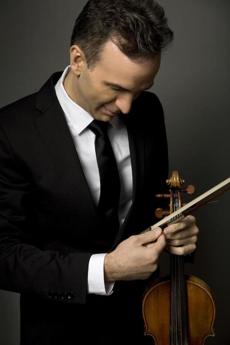by Daniel Hathaway

Alone means, of course, violin without its customary baroque underpinning of bass line and harmony supplied by continuo instruments. Bach, with his uncanny way of creating multiple layers out of single melodic lines, makes you feel that nothing is missing — even when he writes virtual fugues — but a lot of the magic remains to be supplied by the performer, who is as solitary and just about as vulnerable on stage as a musician can be.
Gil Shaham has kept his ears open to the historical performance movement — he plays with little vibrato and has experimented with baroque bows and bridges — but there’s a natural, unfussy quality to his playing that puts the music before the technique and equipment he uses to produce it. Utterly calm in his body movements and pristine in his intonation, he relaxes the audience and lets Bach’s genius shine through in all its brilliance.
Shaham’s program, which he is touring this winter in striking alternation with the Korngold concerto, began and ended with four-movement sonatas — No. 2 in a minor and No. 3 in C — with the d minor Partita in the middle.
Gil Shaham took subtle rhythmic liberties in the Fugue of the second sonata, designed to expressively point up entries of the subject, created a nicely-layered melody with accompaniment in the Andante and displayed amazingly clean technique in the final Allegro.
In the Partita, the violinist seized the individual spirit of the four dance movements, creating lovely echoes in the Allemande, and going on to shape a lively Corrente, a meditative Sarabande and an impressively agile Giga. Shaham took a winning approach to the Ciaccona, acknowledging its monumentality but beginning it at a good clip and letting it unfurl itself with a minimum of intervention. It was Bach who created its grand arch, but Shaham brought it to life with both reverence and coherence. The sotto voce section following the return of the original theme was an edge-of-your-seats moment.
Having been elevated to such an emotional high point, it would have been cathartic for the audience — even if exhausting for the performer — if the denouement of the third sonata had followed rather than the interruption of an intermission. In any case, Gil Shaham returned twenty minutes later to send the large and enthusiastic crowd off into the night with a beautifully layered Adagio, a lengthy but compelling fugue that ran the whole gamut of the instrument, an expressive Largo and a vivacious, perpetual motion Allegro assai. No encore was needed, though the audience was certainly game to hear more.
Published on ClevelandClassical.com February 11, 2014
Click here for a printable version of this article.



